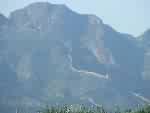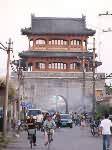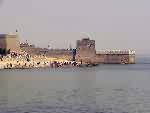- Getting around Lijiang. Dont stay in the Old Towns more than 2 days, there is nothing to do. KRISS Oct 9, 2013 05:46
- 2013 Beijing Temple Fair BENNYLAU Feb 26, 2013 03:29
- Malaysian traveling from KUL - LAX vis Shanghai PVG ZATI_DY Jan 3, 2013 20:15
Shanhaiguan - Where It Begins
- Views: 6104
- |Vote: 0 0
- |Add to Favorites
- |Recommend to Friends
The Manifold Alternatives at the Wall
It never ceases to amaze me how rarely the imaginations of travellers in China go outside the margins of the commonly-trodden road. China’s land mass is unthinkably vast and the possibilities are endless, and yet so many backpackers, otherwise known to be curious creatures, prefer not to think past the few most well worn pages of their travel guide.
The standard excuse is a lack of time, money, or the fact that there are certain things on the China itinerary that quite simply cannot be passed by. The Terracotta Warriors in Xi’an are one, as is the Shanghai Bund – and it goes without saying that the number one destination has to be the Great Wall. Stretching most of the way across the North of the country, the Wall is perhaps the greatest cultural achievement of the Chinese people apart from the language itself (which in its written form is probably the greatest and most complex achievement in world history). Built perhaps as much to keep Chinese culture in as to keep foreigners out, it is the symbol of Chinese unity and isolation.
Visitors to China generally head to Beijing to see the Great Wall. There are three main areas that have developed tourist industries, and of these the two most commonly visited are Badaling and Simatai. Roughly speaking, Badaling is the choice of travellers who wish to see the Wall in as much comfort as possible, and it is therefore the most frequently visited. Simatai is for the more adventurous, and is known as a rougher section of the Wall for those who prefer not just to climb but to stumble and sweat their way skywards.
Few travellers really stop to think, however, that the Great Wall offers many other possibilities than just these two. The very fact of the length of the Great Wall that gives it its reputation means that there are multiple locations where it’s possible to enjoy its spectacle of castellated passways snaking their way across mountain ranges. ..
One fascinating alternative is right at the beginning of the Wall in the East, where the brick rises out from the sea and begins its ten thousand mile march out to the West. Known as the ‘Old Dragon’s Head’, the seaside Wall runs inland to form part of the city walls of Shanhaiguan and then up into the mountains of Jiaoshan. Shanhaiguan is the city of the ‘First Pass under Heaven’, originally the first gateway through the Wall into Manchuria, now called Dongbei. This is also the part of the Wall made famous by the legend of Meng Jiang Nv, who destroyed a section of the Wall with the passion and despair of her tears alone – the girl who ‘cried the Great Wall down’. Meng Jiang Nv’s newlywed husband was one of the millions of Chinese labourers forced to work on the Wall’s construction under the cruel leadership of Qin Shi Huang, and one of the many who lost their lives to the difficult, strenuous and dangerous toil – a fact that makes the otherwise glorious history of the Great Wall uncomfortably tragic even for local Chinese. Meng Jiang Nv, unable to get news of her husband, wailed so powerfully that the Wall fell in the region where her husband lay buried, exposing his bones and those of many others lost.
The City in the Wall
If you’re around Beijing, Shanhaiguan makes for a sensible weekend trip. There are many trains servicing the route and the journey varies from 3 to 6 hours depending on the type of train you book. An early rise on Saturday should see you there by lunchtime. I’m not so good at mornings, and so got a train that would arrive in the late afternoon. I was accompanied by an old travel companion from New Zealand who goes by the Chinese name of ‘Lao Hei’, and a young Korean woman in our care for the weekend, Danbee. The idea was to show Danbee both the Great Wall and a side of the traditional China you can’t find in the capital, and do it as inexpensively as possible. The tactic worked; at a train ticket price of only 24 yuan, the entire trip would cost less than an afternoon at Badaling. The train journey’s exceptional as well, with unrivalled views of the green-gold pasturelands out to the east of Beijing, and passing into Hebei province, great mountains rise in the near distance above the farmlands in staggering blue and grey shadow. Lao Hei bought peanuts and malty Beijing beer from the aisle trolley and we watched over the croplands in the highest of spirits and the most relaxed of moods.
We watched the ridges of the mountains from the windows of the train in the hope of catching glimpses of the Great Wall, and when we were coming close to the station at Shanhaiguan, we saw it at last, trickling down the mountain slope headed directly for the walled city.
The city within the wall is less than a kilometre’s walk from the station, and we were pleased to enjoy the stroll – or at least would have been, had the hopeful tout who’d wanted to sell us a tour ticket would have left us alone. Despite numerous refusals, she followed behind us in a taxi, pulling up next to us whenever we paused, to holler rephrased offers through the passenger window – and when we took a side path where the taxi couldn’t follow, she hurried after us for a distance on foot, ducking behind trees whenever we turned to see if she was still there. It’s possible that she would have tried to extract a tip from whatever hotel we chose, claiming she’d led us there, or that she wanted to see where we were staying so that she could make fresh offers the next day. It took half an hour to lose her.
Outside the city wall, Shanhaiguan looks like an ordinary Chinese small town, with the characteristic rows of almost identical six-floor apartment blocks like dominoes. Inside the wall, however, has been preserved a China difficult to find these days. At the edges of the wall, grassy wide spaces border long, willow-lined roadways that quickly dissolve into a mazework of hutongs crossing through clusters of single-story stone homes of brick and marble with old-style tiled roofs, many set in a slow curve characteristic only of the architecture in this region. The roads are old roads, uneven slabs of laid marble worn at the edges into fine, grey dust.
Walled cities are far less common in China than they used to be, and this one was a complete contrast in atmosphere from the regular tourist road. The afternoon quiet bustle of locals making their way along familiar twists in the pathways lent a welcoming humanity to a set that could be in a museum. Tourists were extremely few, the majority of visitors to Shanhaiguan being national Chinese staying outside the wall, uninterested in revisiting the poorer living conditions of their childhood.
There are a couple of visitors’ attractions inside the walled city. The central drum tower and the structures at the city’s gates are free to wander through and are very typical of cities of this style. To the South is a humble museum for the Great Wall, with a few moderately interesting exhibits for a door price of ten yuan – a good introduction for those new to the Great Wall. More to the centre of town, the First Pass under Heaven Museum, at fifty yuan, is the site of the preserved gateway itself, the reason for the existence of the city in the first place. All of these sites can be visited on foot, as the entire interior of the walled city can be walked right through within an hour.
There were several hotels, but we chose a Chinese traveller’s hostel in a traditional siheyuan – an enclosed circle of rooms arranged in a square around a central courtyard with a single entrance gate – for a mere 25 yuan a bed. It was the ideal China choice, an old marble construction with grasses growing between the roof tiles. In the evening, we briefly rested to the sounds of distant motorcyclettes humming like cartwheels, crickets and the voices of passing villagers. The courtyard was frequented by bright fireflies floating like green neon stars across the face of the marble walls.
In the night, we walked through the shadowy streets, and stopped at a sidestreet stall roasting lamb and mantou skewers and sat in the warm air at a plastic folding table. Shanhaiguan had gradually wound to a crawl about us; there were few people out and the old homes saw the passage of another evening at the base of the Great Wall. We couldn’t have been in a more satisfying place on Earth.
Head of the Dragon
The dawn calmly crept over the worn roofs and dusty stone walls in Shanhaiguan. We left our hostel at eight – unfortunately, well past the time the locals go out for their breakfast of dou jiang and you tiao (soymilk and fried bread) but found a restaurant serving exceptional tang baozi (streamed buns with a spoonful of hot soup in with the filling). Passing taxis entreated us to take a fare to the Old Dragon’s Head, but once we’d walked a short distance south of the Wall, we found a publics bus – number 13 – which took us there for one yuan each.
The Old Dragon’s Head museum also costs fifty yuan, and it’s money very well spent. We began at Longwu Navy Camp, a military establishment dating back from the early Ming Dynasty to protect the capital from the restless Manchu and fully restored in 1992. We wandered through focussed primarily on the search for the elusive shore: although we were only a stone’s throw from the sea, we had yet to see evidence that we were close to the beach, a sight we’d been longing for since moving to Beijing.
The naval camp backs on to another restored ruin, the remains of the Ming Dynasty city of Ninghai. If you’re going to invade China, it’s here you need to take out first, something the British did at the turn of the last century, and the Japanese also around the time of the Second World War. Wandering through in search of the ocean, however, seemed to lead only to dead ends, and we were beginning to hold the fact of its proximity under suspicion. Soon, however, we came to a small canopy of trees, and when we passed through we were rewarded at last. There, at the edge of the dry summer eastern reaches of Hebei was a beach of fine, soft sand and the calm swaying of a sapphire blue sea.
To our left: the imposing Wall stood impregnable over the waves and sand. It has been fully restored, using mostly the bricks of the original discovered in 1988, and once more divides China along the border of Dongbei; and as we stood admiringly on the beach, Lao Hei said in a satisfied voice: if anyone is going to see any part of the Great Wall, then it should be here. Where it begins.






 Copyright © 1998-2026 All rights reserved.
Copyright © 1998-2026 All rights reserved.
1.
Aug 16, 2011 06:13 Reply
Ms.FI from Scotland said:
Hi, it counds great! Can you recommend a hostel in Shanhaiguan? Thanks, fi_ontheroad@yahoo.com
Aug 19, 2011 04:23
Mr.DAVE replied:
I lived in Shanhai Holiday Hotel (山海假日酒店). It's nice.